Finally, the acoustic guitars.
I’m going to exclude the “classical” / nylon-stringed types, because quite frankly I know nothing about the type, never having played classical guitar nor even been a fan of the genre. (Yeah, John Williams, Andres Segovia, Julian Bream… I have a few of their albums but mostly for background listening.)
Let’s talk about the others.
I’ve always been a fan of “big box” a.k.a. “dreadnought”-style guitars such as the Martin D45 (D for dreadnought):
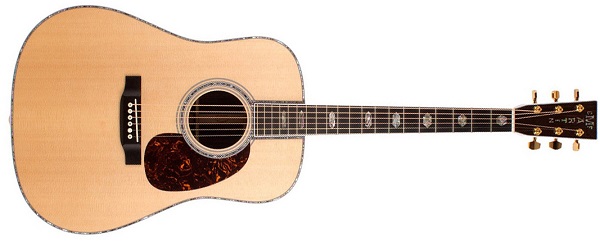
…which are the Rolls-Royce, if you will, of box guitars. The Gibson J200 (J for jumbo, geddit?) is the Bentley of the same:
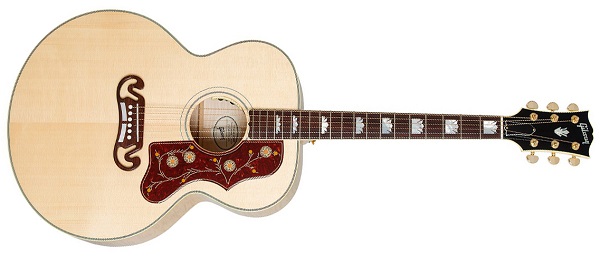
Myself, I prefer the Gibson Jumbo shape (those curves remind me of a recumbent Sophia Loren hubba hubba). For those who care not for the shape, Gibson’s squared-off dreadnought style should do, e.g. the Hummingbird:
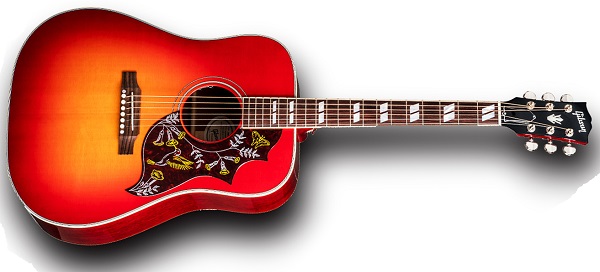
I should point out that Gibson acoustic guitars are not made in the “regular” Gibson plants in Tennessee etc., but at their custom shop in Wyoming. As far as price goes, they are only marginally less expensive than Martin.
Changing gears a bit, I have to confess that while the booming sound of the dreadnoughts and jumbos are a personal liking, I also enjoy the compact, compressed sound of the Ovation round-backed acoustics:
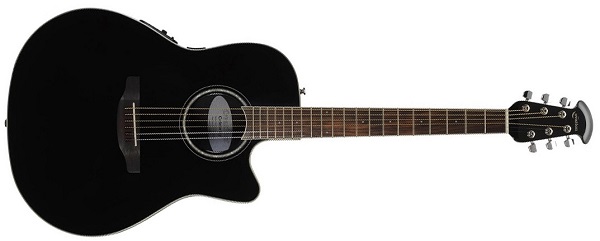
As a rule, they’re also a little less fragile than your regular-built acoustics because their back shell is shaped plastic and not flat wood. Also, they’re a generally lot cheaper than the Gibsons and Martins.
.I’ve never been able to play 12-stringed guitars. Even when my left-hand fingertips were calloused from 6-night-per-week professional bassplaying, 12-string guitars always beat up my fingers. I like the sound of a 12-string, though; and I have to admit, if I played acoustic guitars more often, I could be tempted into an Ovation double-neck:
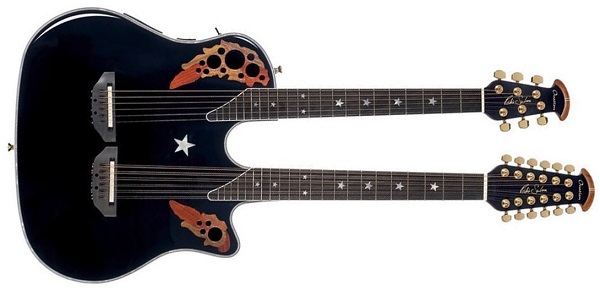
…even though this particular model is a little too Hank Williams Shirt for my liking.
Next, we come to Taylor, but I must confess I don’t know a great deal about them other than that the ones I’ve heard have sounded wonderful. (Taylor guitars were a rarity in my South African yoof.) The ones which did catch my fancy were the Grand Auditorium line, whose sound and resonance blew me away:
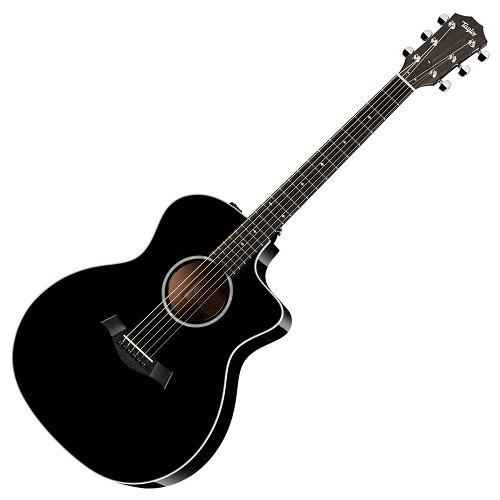
Finally, we come to Yamaha LL guitars, and I really like the sound of the 16:
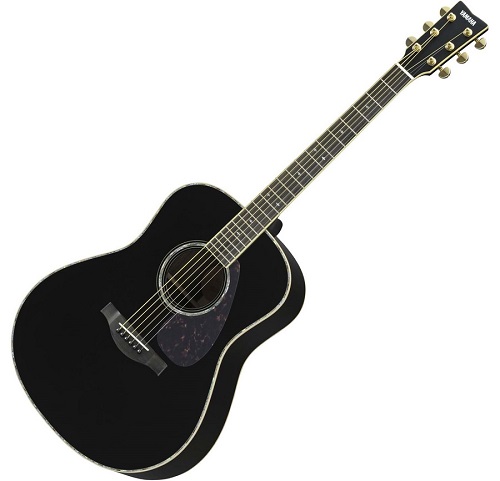
As with all guitars, once you’ve got a baseline sound — the kind of sound that appeals to you — it all comes down to feel: how the neck feels to your hand and how the box “sits” against your body.
And you don’t have to spend a ton of money on your box guitar, especially if all you’re doing is strumming away on your own, or at most playing it for a family & friends singalong. Hell, I taught myself to play on a 3/4-scale Hofner nylon-stringed guitar, and it served me well in the above functions for over a decade. And even when I “graduated” to the big time and played little solo gigs in bars and such, an Ibanez Artwood model worked just fine:
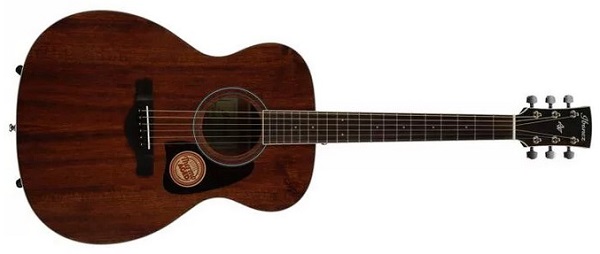
Nowadays, they run about $300, and they still sound fantastic. (The “ordinary” Ibanez acoustics are about half that price.)
One last thing: I preferred a “dark” sound on my box guitars, so I played using really heavy strings (D’Addario Medium Baritone 0.16), which also didn’t lose their tuning as quickly as the lighter ones. If you are of the same mind, make sure to get a guitar with a well-constructed neck, or else you’re just going to bow or warp the thing. Don’t ask me how I know this.
That’s the end of the Test Bed series. Sadly, I can’t do keyboards or drums, because technology has improved so much in recent years that I’m now hopelessly out of touch.
Story of my life…

Obligatory tale of woe from 2009, the second-worst thing to happen to United Airlines:
https://youtu.be/5YGc4zOqozo
Off topic, but in a related sense:
..That’s the end of the Test Bed series. Sadly, I can’t do keyboards or drums, because technology has improved so much in recent years that I’m now hopelessly out of touch.
Story of my life…
I recently bought a Nikon Df Digital Single Lens Reflex (DSLR) body, and fitted it with a Nikkor 28-105 f/3.4~4.5 AF lens. The controls on the top and front of the camera mimic a late ’80s, mid ’90s Nikon FE film camera, being straight-up analog knobs and dials. Most all of the digital frippery is found on the back of the camera, of which I’m still grinding the homework.
A basic but thorough “walk through” of the controls on You Tube is just under 43 minutes. The User’s Manual is 396 pages. That’s just for the body, not counting any lens(es).
My previous Nikon F2a & FE/MD-12 system was heavily equipped with a wide array of fast, prime lenses, Nuke level strobes and more wee accessories than the average gun bag enjoys. Sold it all off in ’03, when film processing was growing scarce, and the effects of salt air on the system were showing “first signs”.
So, from ’03 till now, I’ve been out of touch with the photographic world. And it has completely passed me by, save for basic exposure and optical principles. I am a Luddite and a Dinosaur in a Digital Haze.
Jim
Sunk New Dawn
Galveston, TX
If I played guitar, which I don’t, I’d go with the Gibson rather than the Martin simply because of what the gomment did to Gibson, whose CEO supported Republicans, about exotic wood legally imported from India and pointedly did not do to Martin whose senior executive was a big DemocRat supporter.
That is a VERY valid argument for buying Gibson.
When I was grade school, my mother bought me a 6-string a acoustic. Don’t recall what brand, it was whatever we could afford. It was the mid 60’s, and I learned to play popular folk songs from music sheets with chord charts. I never did learn to read music.
While stationed in West Germany in the mid-70’s, I had a buddy who played at about the same level I did, but knew a bit more about guitars. He came into my barracks room on day with an AAFEES catalog (Army Air Force Exchange Service). Think department store for .mil. He was ecstatic that the catalog listed Ovation guitars. I wound up ordering a Model 1115-4 and hard case exactly like this one–
https://reverb.com/item/3010796-vintage-ovation-12-string-acoustic-guitar-model-no-1115-4-u-s-a-129624-w-case
Guitar–$290, case–$59. Still have it, along with all the original paperwork. I have not played in decades, but really need to pick it up again. When our oldest son showed an interest, I re-strung it as a 6-string for him to start with, which is how it sits now. I think I will start there. The sound it puts out with light guage bright bronze strings (6 or 12) is wonderful. My only minor gripe is that the round back tends to slide off your lap. I use a strap.
When and where were you stationed in Germany? I was in Wildflecken from 74-77 as a combat engineer and ambulance driver. Remember all the top of the line audio equipment, and the hash? lol
Same as you, 74-77. 156 Maint. Co., MOS 45B–Small Arms Repair. Stationed at Pinder Barracks, Zirndorf. I spent a few weeks TDY with a sister company supporting the 11th Cav in Schweinfurt. Interesting history as my dad was 8th Air Force, B-17 pilot, and helped flatten the place in WWII.
Yeah, I remember. I was never into the drug stuff. I watched a close family member die of lung cancer when I was young. To this day, the only time I smoke is if I’m on fire.
The audio equipment was awesome. I never bought any, but my buddy did. One night he was on post guard riding shotgun in the roving jeep. Some idiot had spray painted “FTA” on some of the buildings, and his relief got orders to check the dumpsters for spray paint cans. He didn’t find any cans, but he scored a duffel bag half full of LP’s somebody had pitched. They drove by our barracks and he ran in and dumped it in our room. The LP’s were everything from Tony Bennett to Barbara Streisand to the Rolling Stones.
Respectfully, I’d suggest you’ve left out the “reference” guitar is expect to find in any well equipped studio, the Martin D28. It’s unquestionably the most recorded acoustic guitar ever.
If I have to replace my 30odd year old Maton (Aussie brand) I’d be straight to my Nearest Taylor retailer, they are imho the PRS of acoustics – blending astonishing quality with technical innovation.
Speaking of Maton guitars, for those who don’t know him I highly recommend a few minutes on YouTube checking out Another Aussie, Tommy Emmanuel. Start with his rendition of the old Mason Williams song, Classical Gas.
The only thing I know about classical acoustics is the very first guitar I bought at age 12 in 1967 was a nylon stringed acoustic from Woolworth’s for $35. I mowed lawns for $3 a crack to but that thing. Didn’t like the dull sound so I put steel strings on it and within a year the neck bowed so bad as to me non-useable, time to move up.
A lot of water flowed under the bridge and in a low moment of my life I bought a $65 Harmony Marquis 6 string steel in black in 1983 and played the hell out of it and still have it and it still looks new. Last year I tore it down and cleaned and maintenanced it to where it is now better than new.
In 1992 times were better and I bought a Charvel 625c electric-acoustic with the jumbo body. Deep belly. Wow. Not this is what a guitar is supposed to be! I still have it, stills sounds wonderful, still looks like new. Played it yesterday after noon sitting on the porch in the sun. I have Elixir strings on all my guitars.
One nice thing about Gibson, and Taylor to some extent, is they don’t build beginner and novice instruments. You are going to pay though. Hummingbirds are OK, however, most I know that play Gibson Acoustics play the venerable J series.
You have to be careful with Ovations, and make sure it’s pre Fender (2007 or so) or brand new. Kaman ones are the best, having been built in CT. Don’t look, don’t even touch the ones built in China. They are crap squared. I’ve restored nearly half a dozen vintage ones, and bought one or two chinee ones, which I ended up either donating or chucking.
I’d agree with Skippy above, the D-28 Martin is iconic one. Two big important things about Martins. First, somewhere along the line the instituted a money back guarantee. Shortly after, the Stradivarius quality builds ended and the guitars became more sturdy. They still sound good, but they don’t sing like they used to. So to get a good one you are going to have to but custom shop/signature edition, or score a vintage one. How can you tell? Look in the sound hole of the older models. They glued silk bands to the sides to keep the thing from shattering to pieces if you dropped it. Second, when the Obama economy started to hurt them, (Which they deserved), the CEO started a budget line of guitars. These are OK, but don’t kid yourself. They aren’t any better than anyone else’s at that price. That said, his logic was sound. He had to keep his people working and fed. You can’t just hire any LaShawn off the street to properly set a neck in an acoustic or assemble the neck in the first place.
My advice is, and is for any instrument, if you are going to take it up buy a decent one. By that, I mean an intermediate player model at least. You’ll be spending 500-700 bucks. But what you’ll get is a mnore pleasing sound, and an action that won’t destroy your hands. Buy good strings, and change them when they get dull.
I’m an early GenX, But I’m about to do a boomer thing and blither about the olden days.
Back when I was a teen – maybe early 80s? A really decent name brand instrument was within reach of the common fool kid like me. A friend of mine wanted an acoustic guitar, and settled on a Yamaha. Decent enough model, I’m sure he spent around $200. When he got it, the counter dude let us play a top of the line Yamaha, I’m going to guess was 300 or so. Then he let us play the bottom of the line Gibson, which was the same price. No comparison. None. The Gibson, while not as pretty, sang. I still remember the scene.
Had you bought the Yamaha then, you’d have nothing. A nice vintage instrument, but ok. If you still had the Gibson, you’d be up thousands.
It must be hard for the manufacturers, first when their biggest competitor is all the old stock floating around in the second hand market.
Second, as a herd, guitar players are insanely conservative which I think accounts for the fact that pretty much every guitar in the Gibson, Fender, Martin lineups are all pretty much replicas of the gear they were making in the 1950s. To be fair, they try to innovate, I’ve got an 80s strat with Lace Sensor pickups, locking tuners, Wilkinson roller nut, tone boost circuit and some fancy bridge setup (all stock) and yet virtually all of these improvements have been rejected by the market.
I remember when I bought that strat I was impressed by the features. The guy in the shop tried very hard to get me to buy a standard US strat which was considerably cheaper that the one I liked. From a resale view he was probably right, my strat plus deluxe has not held value as well as standard strats of the same age and every time I pick up a 70s or 80s strat I think they sound um, more strat like than mine. No issue for me as I bought it to use it, not as an investment strategy.